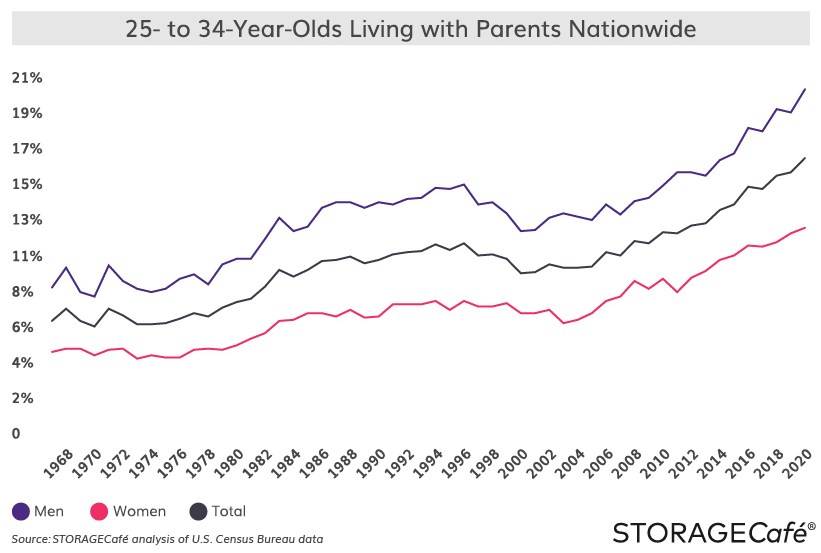
Multi-Generational Living Reaches 50-Year High

(Chart courtesy of StorageCafe.)
StorageCafe, Santa Barbara, Calif., reported more than 4.6 million multi-generational households in the U.S. as of 2020, the highest number in 50 years—and not for the usual reasons.
The report noted multi-generational living has historically been associated with necessity, and its affordability is still a key asset. But now, more than just providing a temporary solution to economic challenges, the multi-generational household has evolved into an arrangement that mutually benefits family members. ‘Boomerang kids’ are now joined by older millennials who increasingly consider staying with mom and pop, enjoying shared expenses and assistance with childcare.
Additionally, the report said as work from home has become so widespread, keeping people away from regular face-to-face professional interaction, sharing space with family is often a viable alternative to spending most of the day alone.
The report said more than half the country’s 18- to 24-year-olds live with parents. And 17% of 25- to 34-year-olds — which include most of the Millennial cohort — do too, more than twice the number that did so 50 years previously. They may be joined in multi-generational households by grandparents and children.
Ashley Ermer, professor of Family Science and Human Development at Montclair State University, noted adults are marrying later. “It used to be the case where young adults would marry in their early 20s, which also meant they were leaving their parents’ home in many cases,” she said. “The average first age of marriage in the U.S. is approaching 28 for women and 30 for men. The economy is another reason. Those in their late 20s/early 30s were entering the workforce in large numbers around or slightly after the Great Recession.”
Key report findings:
–Multi-generational living has risen considerably in recent years, from 27.3% of 18- to 34-year-olds living with their parents in 2007 to 32.7% to 2020.
–There are now more than 4.6 million multi-generational households in the U.S.
–17% of 25- to 34-year-olds now live with parents, compared to just 7%-8% half a century ago.
–Men in the 25-34 age bracket are one-and-a-half times more likely than women to be living with their parents.
–Multi-generational living supports teleworking from home, which has increased in most U.S. urban hubs, with LA and Phoenix leading the way.
–50% young adults in Oxnard, Calif., live with their parents, the highest percentage of any U.S. metro, with Riverside, Calif., and Bridgeport, Conn., close behind.
“The parents have fewer children and larger homes and the relationships between these two generations are better,” said Clinton Gudmunson, Professor of Human Development and Family Studies at Iowa State University. “Also, the children are facing more costly housing to get out on their own and marrying later so it is easier all around to just stay in the parents’ home.”
The report noted multi-generational living is common in many societies and the U.S. is no different. However, for several decades after World War II, it became less common as spending power increased and a “new spirit of independence gripped many people.” But the trend for extended family households started to rise again in the late ‘70s, as home prices went up, making independent living less sustainable. It then plateaued for much of the ‘90s but started increasing again when the nation experienced economic challenges in 2007 and has continued rising for much of the past decade. Boomerang kids are now joined by downsizing grandparents who look for more relaxed lifestyles as well as remote workers to form the largest multi-generational living cohort of the past 50 years.
For the first 20-30 years, the biggest issue was the increase in age at marriage, which skyrocketed between 1960 and 1980-90 and has continued to drift upwards though more slowly,” said Frances Goldschneider, professor of family science with the University of Maryland. “Young adults are very unlikely to stay/return home if they are married or cohabiting. In fact, during that early period, unmarried young adults actually became less likely to live with parents, but that change was overwhelmed by the growth in the unmarried. In the later period, however, the big issues appear to be financial; young adults are having much more trouble getting ‘launched,’ both because of a relatively poor job market and the skyrocketing costs of housing.”
